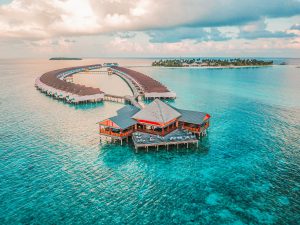Located to the southwest of India in the Indian Ocean, this gorgeous string of atolls is world famous as a romantic getaway. The countless pretty sandbars and atoll lagoons with amazing deserted beaches form the postcard-perfect scenery for which the Maldives is ever popular. Lazing on a private beach, relaxing in an infinity pool, or enjoying sensual spa treatments at one of the numerous luxury water bungalow resorts, is the extent of most tourist activities in Maldives. However, being a country with enormous ocean space and little land resources, watersports such as surfing and windsailing are available. But the Maldives have also become famous for its world-class diving adventures. Big schools of fish and plenty of sharks inhabit the waters, and diving in the Maldives has become known as one of the best places in the world to dive with whale sharks, manta rays and hammerhead sharks – all often on the same memorable visit!

Water chalets in the Maldives
However, the government felt confident enough to re-open the country on 15 July to international visitors, one of the first countries to do so, in an attempt to limit the negative consequences on the economy. Passengers were required to have a confirmed booking before travel and to stay at only one resort or hotel during their visit. This is allowed some control over tourist movements, and tracking and quarantining any cases that were identified. This meant that the Maldives still managed to welcome over half a million tourists in 2020, during a year when most of the world was under some form of lockdown.
Since 20 September, it is mandatory to present a negative PCR test result on arrival together with a Traveler Health Declaration form. Travel from one resort to another is now permitted. The Maldives also recently opened its borders to Indian tourists as of 15 July 2021. Further information can be found here: Maldives Immigration entry requirements![]() .
.
The Maldives has recorded 80,000 cases and just 200+ deaths to date. It is ranked at 110 in the list of countries with the worst death rate per capita, making it a relatively safe place to visit. Most cases and deaths occurred between May and July 2021, due to the arrival of the Delta variant from nearby India. The spike has since dissipated, no doubt in part due to 57% of the population being fully vaccinated. Excess death statistics show that official numbers have been under-declared, and actual deaths are nearer 500, or 2 times / 100% higher than the official number.
Our Maldives liveaboards have been one of our most popular choices over the past 18 months, with many scuba divers taking advantage of the amazing special offers that were in place. There are various itineraries, each offering something different.
1. The most popular and common route is the Central Atolls route of the North and South Male atolls and Ari Atoll. This is where you will find most of the boats. These cruises focus on 3 of the main attractions of diving in the Maldives – whale sharks, mantas and hammerheads – and there is a very good chance that you could see all 3 in just one week! They are also very easy for visitors to plan as they depart and return from Male City, right next to the international airport. Most other itineraries are likely to require a stunning low level domestic flight to and/or from the port of departure/disembarkation. This is a year round route.
2. The Southern Atolls are generally for more experienced divers. The area is renowned for its current swept channels where the superb visibility allows you to encounter dozens of reef and hammerhead sharks and eagle rays, as well as big schools of pelagics such as trevallies and barracudas. Other highlights include some monster-sized nurse sharks, and there are some locations where you can spot whale sharks and mantas too. Other parts further to the south are known for their healthy coral structures.
3. The Northern Atolls are home to Hanifaru Bay, where you can see the amazing sight of dozens of whale sharks and manta rays feeding from May to December; it’s the kind of breathtaking underwater image that few places on Earth can promise. Other highlights of the region include its famed biomass – huge volumes of fish, as well as large squadrons of grey reef sharks. This is a good option in the green season.
4. The Far North Atolls are well off-the-beaten-track, where there has been minimal human interference and the colourful corals and marine life flourishes. Here you will have the entire ocean to yourself, enjoying drift and wall dives, cave systems and a wreck or two. Manta rays, reef and leopard sharks are frequently seen, as well as less common creatures such as guitar sharks.
5. The Deep South is more of an unchartered territory. Occasional diving safaris venture down here Dec-Apr in the hope of catching sight of the truly spectacular, such as tiger and thresher sharks, but also hammerheads, whale sharks and mantas. This area is strictly for advanced divers and those with a spirit of adventure.
All boats provide onboard COVID PCR tests for guests that require one to return home after their cruise. So that is one less obstacle for you to come and enjoy the marine life of the Maldives.